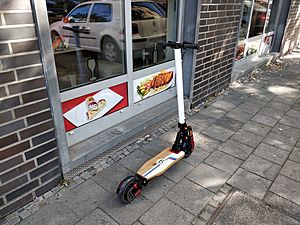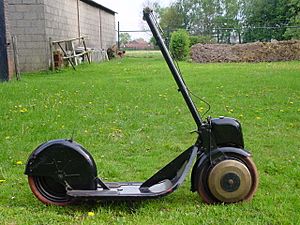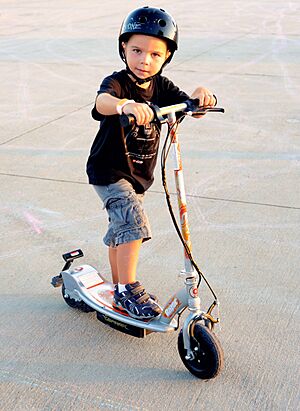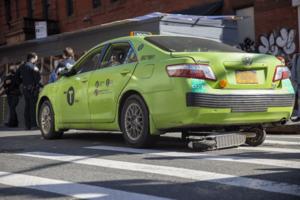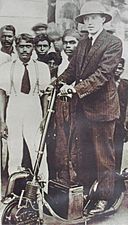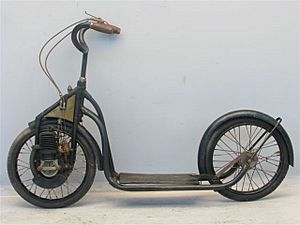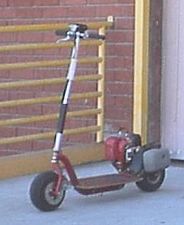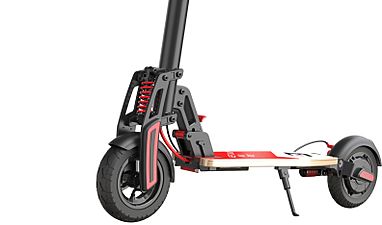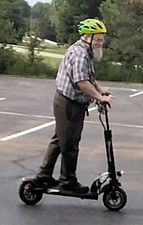Motorized scooter facts for kids
A motorized scooter is a type of scooter that has a small engine or an electric motor. Riders stand on a large flat part in the middle. The first motorized scooter was made by a company called Autoped in 1915.
Recently, electric kick scooters (also known as e-scooters) have become very popular. This is because of scooter-sharing systems. These systems let people rent scooters for a short time using a phone app. You can find these systems in many cities around the world.
History of Motorized Scooters
- 1915: The Autoped company created the first stand-up scooter. You could stop it by pulling back on the handlebar. They made these until 1921.
- 1986: Go-Ped introduced the first modern stand-up scooters, called the Roadster and Sport.
- 2001: Go-Ped also made the first e-scooter with a full suspension system, called the Hoverboard.
- 2009: An Israeli designer named Ricardo Nimrod Sapir designed the first e-scooter that could fold up.
- 2010: Sapir started making these folding e-scooters with lithium-ion batteries.
- 2018: Companies started offering dockless (meaning no fixed parking spots) scooter-sharing systems in many big cities. These often grew out of bike-sharing systems.
E-Scooters: How They Work
Electric kick scooters are now more popular than scooters with gas engines. They usually have two wheels, about 8 to 11 inches (20 to 28 cm) wide. One or both wheels have an electric motor inside. Riders stand on a platform between the wheels and use a handlebar to steer.
Because they use an electric motor, e-scooters don't need gears. Some can even get energy back when you slow down, which is called regenerative braking. How far an e-scooter can go and how fast it can travel can be very different depending on the model. Some can go from 3 to 220 kilometers (2 to 137 miles) and reach speeds from 19 to 120 kilometers per hour (12 to 75 mph).
In 2017, companies like Lime and Bird started offering dockless e-scooter sharing services. This means you can pick up and drop off scooters almost anywhere. These services became very popular in 2018, with many e-scooters appearing in cities worldwide. Rules for using e-scooters on public roads and sidewalks are different in different places.
All About E-Scooters
How People Use Them
Motorized kick scooters are used for many things. Police officers and security guards use them for patrolling. People also use them for fun. New ride-sharing apps have made e-scooters easy to find and use. They are popular in cities as a way to get around instead of biking or walking short distances.
E-Scooters and the Environment
E-scooters and other electric vehicles can help reduce global warming by lowering carbon dioxide (CO2) pollution. This happens if people use them instead of cars that burn gasoline. However, if people use e-scooters instead of walking or biking, they might not be as good for the environment. Making the batteries for e-scooters uses resources, and these batteries are not always recycled.
Some studies show that rented e-scooters might actually create more CO2 than the ways people used to travel. This is because of how they are collected, charged, and moved around.
Staying Safe on E-Scooters
E-scooters are a fun way to get around, but like any vehicle, they have safety risks. Riders can get hurt in traffic, similar to pedestrians and bicyclists. For example, in some places, there aren't enough bike lanes, so e-scooter riders might end up on sidewalks, which can be dangerous for people walking.
As e-scooters become more common and some can go very fast, the number of accidents has gone up. One big reason for accidents is that scooters have small wheels. They can become unstable if they hit a pothole or a bump.
When e-scooters are used in busy city areas, safety is a big worry for riders, people walking, and other drivers. Studies have shown that e-scooter riders might sometimes take more risks, like riding in car lanes or going against traffic. It's important to understand these risks to make good rules for e-scooters. For example, cities need to decide if e-scooters should be in bike lanes, car lanes, or somewhere else.
Scooter-sharing companies like Lime often have safety rules printed on the scooters and in their apps. These rules usually say things like: "helmet required," "no riding on sidewalks," and "18+ years old." But people don't always follow these rules, and laws can be different in different cities and states, which makes it hard to control.
In some countries, like Norway, studies found that accidents are much more likely on an electric kick scooter than on a regular bicycle. Also, in London, privately owned e-scooters were banned from public transport after some batteries caught fire.
Rules for E-Scooters
The rules for e-scooters are different in many countries and even in different cities within the same country. Here are a few examples:
Australia
In Queensland, the state government makes the rules for e-scooters. In Canberra, you can ride e-scooters on footpaths, shared paths, and bike paths since 2019. You must wear a bicycle helmet.
Germany
Since 2019, e-scooters are allowed on streets. Scooters that go up to 12 km/h (7.5 mph) can be used by people aged 12 and older on footpaths. Scooters that go up to 20 km/h (12.4 mph) must be ridden on bike paths by people over 14. These faster scooters also need special insurance and a number plate.
New Zealand
E-scooters are seen as "low-powered vehicles" if their motor is under 300 watts. This means they don't need to be registered. You can ride them on footpaths, roads, and bike paths. Helmets are not required, but it's a good idea to wear one.
United States
Rules for e-scooters vary a lot by state. In some places, they are not allowed on public roads because they don't meet car safety rules.
- California: Riders must be 16 or older, have a driver's license, and wear a helmet. They must follow the same traffic rules as cars. Scooters can't be ridden on sidewalks or on streets with speed limits over 25 mph (40 km/h) unless there's a bike lane.
- Washington, D.C.: E-scooters are called "Personal Mobility Devices." This means you don't need a license, insurance, or registration. They are allowed on sidewalks, and helmets are not required.
- Georgia: E-scooters are "Electric Personal Assistive Mobility Devices." They can be used on sidewalks and highways with speed limits up to 35 mph (56 km/h), or in bike lanes. Riders have the same rights as pedestrians.
Even though laws vary, scooter sharing companies often tell riders not to ride on sidewalks.
How E-Scooters Are Built
Wheels and Tires
E-scooters can have solid tires, or air-filled tires (pneumatic). The size of the wheels usually ranges from 8 to 11 inches (200 to 280 mm). Some scooters have larger wheels for riding on roads or off-road. Most wheels are made of steel or aluminum.
Drive System
The simplest way an e-scooter moves is with a direct drive. This means the electric motor is directly inside the rear wheel. Some e-scooters even have two motors, one for each wheel. This design is very efficient, especially with regenerative braking.
Some scooters use a chain or a belt to transfer power from the engine to the rear wheel. These often have a special clutch that lets the engine run without moving the scooter.
Suspension
A scooter's suspension helps make the ride smoother. Some scooters have no suspension at all. Others have simple spring systems in the front forks, or more complex systems that absorb bumps and shocks.
Brakes
E-scooters can have different types of brakes, like disc brakes or magnetic brakes. Brakes can be on the front wheel, the back wheel, or both. Many newer e-scooters also have a Kinetic Energy Regeneration System (KERS), which helps slow the scooter down and recharge the battery. Some also have an electronic ABS system (E-ABS) to prevent skidding.
Gallery
Companies That Make Scooters
- AER
- Apollo
- Askoll
- Beam
- Bird
- Boosted
- Currus
- EcoReco
- EMOVE
- Evercross
- EVOLV
- E-TWOW
- Fiat
- Fiido
- Fluid Freeride
- Glion
- Globber
- GOTRAX
- Helbiz
- Hiboy
- Jetson
- Inmotion
- Inokim
- Joyor
- Kaabo
- Levy
- Lime
- Mearth
- Mercane
- Mii2
- Minimotors
- Macwheel
- Mongoose
- Nabi Boards
- NAMI
- Nanrobot
- Neuron
- Niu
- Qiewa
- Razor
- RION
- Segway
- Skip Scooters
- Spin
- Splach
- Swagtron
- TAUR
- TurboAnt
- Turbowheel
- Uber
- Unagi
- Uscooters
- Varla
- Vsett
- WEPED
- Work's Electric
- Yume
- Xiaomi
- Zero
See also
 In Spanish: Patinete eléctrico para niños
In Spanish: Patinete eléctrico para niños
- Scooter-sharing system
- Bicycle-sharing system
- Segway PT


